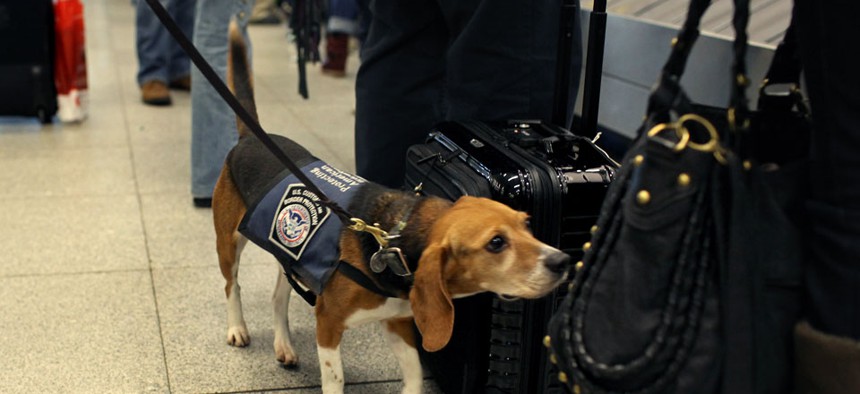The Next Step in Securing the Border: Fido and a Smart-Sensor Collar

Working for the US Customs and Border Protection, Izzy is an agricultural detector beagle whose nose is highly sensitive to food odors. Izzy sniffs incoming baggage and passengers at John F. Kennedy Airport in New York. Craig Ruttle/AP File Photo
Wearable devices are gaining root in protecting U.S. borders.
In the future, sensor-equipped collars could let your dog tell you all about its day.
If it sounds a little far-fetched, consider that the U.S. government is exploring the possibility of outfitting its border-protecting canines with futuristic collars that can, for example, translate a dog’s stress level through its bark and relay that data in real-time to a handler through a mobile device.
In an Oct. 6 speech in Washington, U.S. Customs and Border Patrol Chief Technology Officer Wolf Tombe outlined how innovative technologies, including wearable devices, are gaining root in protecting the nation's borders.
Already, some of CBP’s 58,000-person workforce use various smart wrist-watches, wearable cameras and clothing equipped with health and safety sensors, improving the effectiveness and safety for border agents in the field.
The successes of these wearable devices on human agents may soon lead to wearable devices for the four-legged members of CBP’s canine teams, which have long been considered CBP’s best tool in tracking potential terrorists or sniffing out controlled substances at U.S. borders.
CBP’s canine program is the largest law enforcement canine program in the country, with some 1,500 teams, each with dogs capable of detecting some scents at an astounding four parts per trillion.
“Canines are still our best sensors,” Tombe said.
A dog's keen sense of smell draws them to potentially problematic situations much faster than their human counterparts. Today’s border-defending canines are outfitted with collars that transmit a GPS signal, Tombe said, so agents can’t lose the animals.
But Tombe said CBP is exploring the idea of collars that contain “stress-detection sensors” that could, for example, translate a dog’s bark to its mood via a signal an agent could view on a screen even if the animal was out of sight.
Such a collar could relay to handlers potentially vital information, including whether the dog was stressed or threatened. The collar could also potentially be fitted to send additional data via an audio or video stream.
While Tombe did not identify specific companies that produce these kinds of wearable devices for dogs, it appears there is a niche market for sensor-loaded dog collars. On its website, Israeli-based company Bio-Sense markets to the public a collar that “processes barks and can tell whether your dog is alarmed, senses danger or is just communicating with neighbors.”
According to the website, the collar will notify the owner of a threat via SMS message or a cellular phone call. Interestingly, it lists the Israeli Air Force among its customers.
CBP’s efforts in wearable devices and sensors echo the private sector’s increased interest in connected technologies, collectively dubbed the "Internet of Things." Wearable electronics alone are expected to generate more than $14 billion in 2014, according to independent market researchers IDTechEx. That market will balloon to $70 billion by 2024.
“The Internet of Things is huge for us; it holds great promise for us,” Tombe said. “People are becoming their own sensors.”
So too, apparently, are humanity’s favorite four-legged friends.



